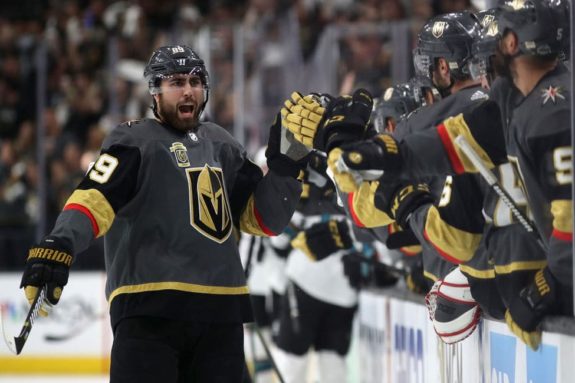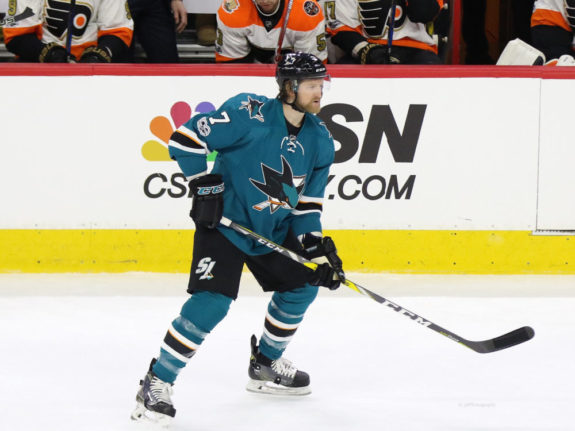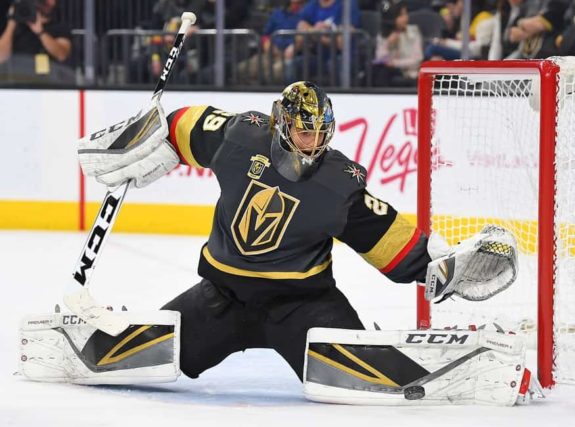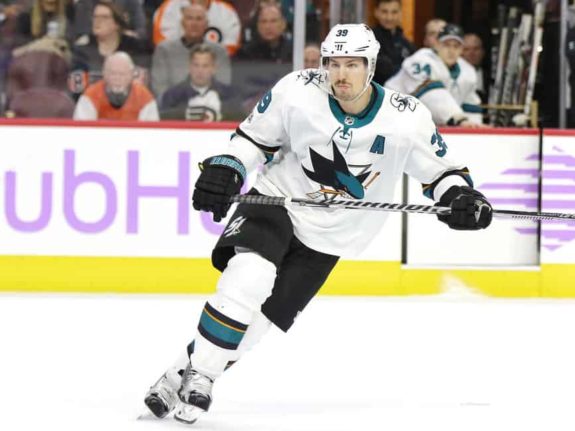For the second straight game, the San Jose Sharks and Vegas Golden Knights finished regulation tied at three. For the second straight game, the Sharks overcame a two goal deficit and tied the game. And, for the second straight game, the Sharks got their most effective offense from power forwards. More specifically, from power forwards playing hard behind the net. The Sharks have one important tactic which works against Vegas, and they need to fully utilize it. But they didn’t utilize it as much as they needed to, and lost Game 3 in overtime, 4-3.
Sharks and Golden Knights, Game 3
The Sharks opening goal came on a power play in the second period, with Timo Meier firing the goal off a terrific cross-ice feed from Chris Tierney. A tripping penalty created the power play which was a direct result of the Sharks taking the play behind the net of Vegas goalie Marc-Andre Fleury.
Down a goal, Vegas stormed back by scoring the next three goals, two on power plays. James Neal was behind the goal line when he fed Colin Miller for the game-tying goal. Vegas went ahead on a power play goal from Jonathan Marchessault, who got a terrific cross-ice feed from Alex Tuch.

Vegas went ahead on a brilliant pass in front of the net by William Karlsson to Reilly Smith, who had an open net and put home the goal to give Vegas a 3-1 lead.
The Sharks battled back in the final regulation period. Evander Kane scored the Sharks second goal moments after a power play expired, closing the gap to 3-2. The game-tying goal came with under two minutes left. Sharks forward Tomas Hertl controlled play behind the net, then barreled forward before knocking home a bouncing puck. Hertl, who took a foolish penalty earlier in the game, has otherwise been among the Sharks best players this series.
How Vegas Thrives
The game-winning goal came after some puzzling play from San Jose. For some reason, the Sharks decided they could compete playing a track-meet style, which is the Vegas sweet spot, not San Jose’s. It proved decisive, and not in a good way for the Sharks. On the game winner, Vegas had a clean break out from their own zone. James Neal and William Karlsson skated quickly through the neutral zone. They attacked Sharks defensemen Brent Burns and Paul Martin – and overmatched the Sharks pair. Karlsson fired the puck past Jones for the winner.

Vegas thrives with this style of play. Quick plays in open ice, especially before the defense gets itself organized, are where Vegas gets their even strength goals. They play a relentless style which forces small mistakes and then they attack before the defense gets properly set.
Quick strike scores are an increasingly important part of NHL success; Vegas’ approach epitomizes this. Importantly, Vegas knows this is what works for them.
Beating Fleury
The best player on either team this series is Fleury; he’s been consistently brilliant. The Sharks simply don’t have a lot of ways to beat him, so it’s essential they understand what works for them.
They’ve beaten Fleury just two ways, thus far. They beat him on the power play four times — I’m including Evander Kane’s score at even strength, which came moments after a Vegas power play expired and before Vegas could regroup. At even strength they’ve beaten Fleury three times – each time by going behind the net and using the team’s strength down low. Play behind the net has also resulted in several power plays, including two where the Sharks scored. Five of the seven Sharks goals in the series are directly tied to play behind the net.

Broken down by game, both even strength goals in Game 2 came from plays by power players behind the net; a third came on a power play drawn with play behind the net.
Two of the Sharks three goals in Game 3 came from play behind the net, Hertl’s even strength score was one, the other from a penalty drawn with play behind the net (Meier’s score). Also, the Sharks best chance to win in overtime came on a play behind the net, and it was a very high quality chance. Joe Pavelski had the puck behind the net and fed Logan Couture, whose shot required Fleury to make his best and biggest save of the series.
The Sharks Needed Change
During Game 3 at even strength, the Sharks often pulled up at the half-wall to set up plays. And they often looked dangerous doing it. But this is the wrong strategy for San Jose. It has yet to result in a single even strength goal this series. And because of this, San Jose has little room for error in this series, now down 2-1.

The bottom line is simple. While the Sharks have looked dangerous playing with the puck in front of the net, this isn’t the way to score goals in this series. To beat Vegas, the Sharks need a prime directive and they need to follow it at every opportunity – get the puck to their power players behind the net and let them go to work. If the team doesn’t do this, they won’t be working much longer this season.
Zeke’s Notes
Prior to the series, many wondered if Sharks head coach Peter DeBoer might consider swapping in defenseman Joakim Ryan over Paul Martin as the partner for Brent Burns (even going back to the first round series). Martin is the veteran and has a lot of experience paired with Burns, but Ryan is faster, more agile and led the team in plus-minus. On the game winner, it was Martin and Burns who were victimized by Karlsson and Neal. For two players supposedly accustomed to each other, they looked lost on the play. There was no shortage of Sharks fans who noticed (and no shortage of their angry profanity related to the play on social media).
DeBoer had already shown skepticism with Martin, playing him only ten minutes in Game 2, a game which lasted 85 minutes. But he rolled with Martin again in Game 3. Many “credited” DeBoer’s decision to stick with Martin the pivotal decision which lost Game 3. It’ll be interesting to see if DeBoer continues to use Martin as the series continues.